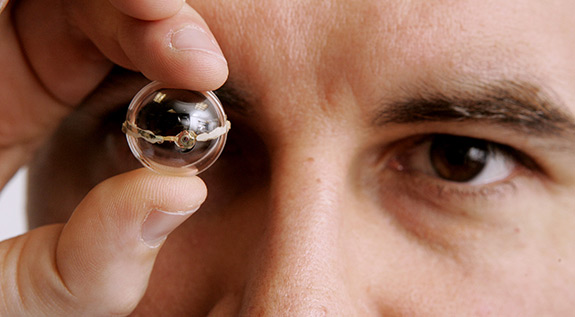Princeton Combines Plastics and QLEDs in Prototype Contact Lens

3D printed contact lens integrated with QLED technology. Courtesy of Frank Wojciechowski.
Latest News
December 15, 2014
Additive manufacturing (AM) is changing the course of manufacturing, not simply because of its ability to form complex geometries in a manner that would be impossible for traditional manufacturing methods, but also because it offers new methods for building multi-material objects. Rather than requiring multiple processes that might not be complementary to produce an object, AM is able to combine materials as part of the same build process.
Princeton has put this aspect of AM to work in developing new ways to combine plastics and active electronics. One of the first proof-of-concept objects to be built using these principles is contact lenses that incorporate quantum dots and semi-conductors. The finished lens is capable of projecting beams of colored light.
 3D printed contact lens integrated with QLED technology. Courtesy of Frank Wojciechowski.
3D printed contact lens integrated with QLED technology. Courtesy of Frank Wojciechowski.One might question what possible practical applications might be developed for shooting beams from your eyes, other than amusing your cats or impersonating one of the Borg. Formed from hard plastic, the lenses in question aren’t actually wearable, either. Lead researcher Michael McAlpine, an assistant professor of mechanical and aerospace engineering, has an answer.
“This shows that we can use 3D printing to create complex electronics including semiconductors,” said McAlpine. “We were able to 3D print an entire device, in this case an LED. We used the quantum dots as an ink. We were able to generate two different colors, orange and green.”
The project was also used to determine the feasibility of leveraging AM to build objects that incorporate materials that usually require diametrically opposed microfabrication techniques to build. As an example, one material might generally require heat as part of the fabrication process, while another material already included in an object might not react in a positive manner to the presence of heat. AM makes it possible to combine these materials in a single process.
“For example, it is not trivial to pattern a thin and uniform coating of nanoparticles and polymers without the involvement of conventional microfabrication techniques, yet the thickness and uniformity of the printed films are two of the critical parameters that determine the performance and yield of the printed active device,” said Yong Lin Kong, project researcher and lead writer of “3D Printed Quantum Dot Light-Emitting Diodes” the paper published in Nano that documented the experiment.
Below you’ll find a short video about multi-material printing.
Subscribe to our FREE magazine, FREE email newsletters or both!
Latest News
About the Author
John NewmanJohn Newman is a Digital Engineering contributor who focuses on 3D printing. Contact him via [email protected] and read his posts on Rapid Ready Technology.
Follow DE





